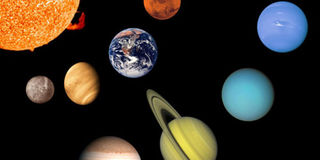Why Mercury and Venus are seen

FILE The Solar System.
Modest Muite Mutua asks a question that every school child should ask the science teacher: “Why is it possible for us to see planets Venus and Mercury at night? Shouldn’t an observer on the equator only see objects that are further away from the sun than the earth?”
To understand where Mutua is coming from, it will help to draw a simple model of the solar system. So my dear reader, go ahead and sketch one quickly: a large circle to represent the sun; then a few circular paths around it (orbits of planets) – four will be enough; then on each orbit, draw a smaller circle to represent a planet.
So now you have the sun in the middle of four planets – Mercury, Venus, Earth and Mars.
Now, planets rotate on their axes, thereby giving us day and night. It is night time if your locality is facing away from the sun. This is the reason why Mutua is puzzled: since Venus and Mercury are “in front” of the Earth, we should not be able to see them at night.
But that is partially correct: these two planets are not visible “in the middle” of the night. They appear in the sky only in the evening and in the morning. In fact, Mercury is only visible for just a few minutes at sunset and at sunrise.
Because of the way the solar system is drawn in most books, many people assume that all the planets lie in a straight line from the sun all the way to Neptune (remember Pluto is no longer classified as a planet). That is not so: they are scattered randomly all around the sun.
Different duration
The reason for this is that they revolve at different speeds, each taking a different duration to complete one revolution: Earth takes 365.25 days (8,766 hours), Venus 5,391 hours, Mercury 2,111 hours; Mars 16,489 hours; and so on.
Because of these variations, not all planets are visible from Earth on all the nights. For example, at the moment, Mercury is hidden from view. It will reappear from the end of April at around 6.45p.m. daily. It will be seen for only about eight minutes and then disappear under the western horizon.
If you look back at your sketch, you will notice that Mercury and Venus can be visible when the line joining Earth to sun makes a right angle with that joining any of them to the sun.
This geometry may not be obvious in a rough sketch, but when it is drawn to scale, it suddenly becomes obvious. To do that, one would need the following important numbers: Mercury lies about 60million-km from the sun and it’s about 4,880km in diameter; Venus, 108million- km and 12,100km across; Earth is 150million-km from the sun and 12,800km in diameter.
Now try a scale of, say, one millimetre representing 1,000km; do you think you can get a large enough piece of paper to draw it?
www.mungaikihanya.com; Twitter: @mungaikihanya




